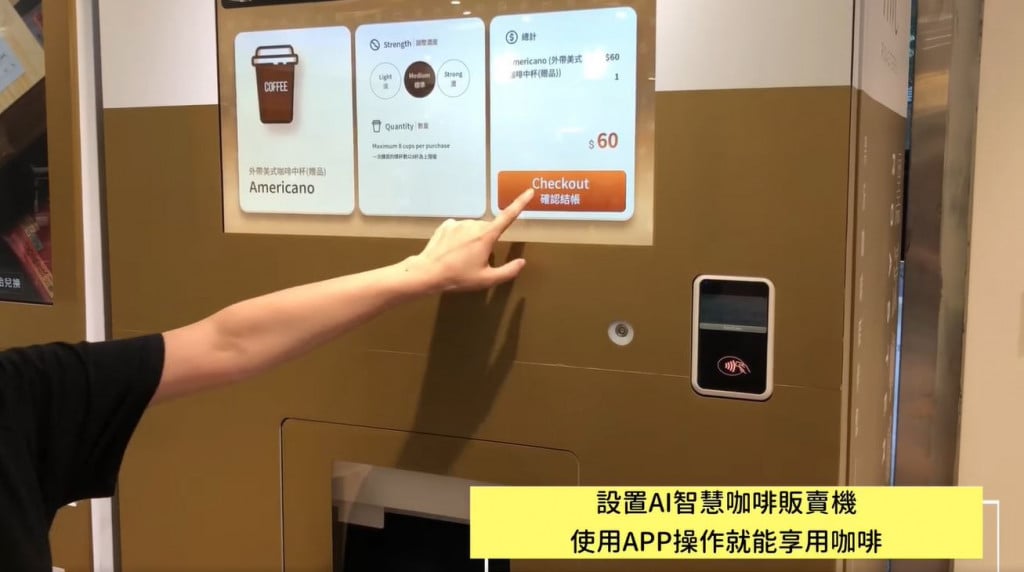【2021 Application Example】 Unmanned Intelligent Vending Machines - Black Wo Coffee Creates Boutique Coffee in a Minute
Technology also carries the aroma of coffee!
Situated on Gaogong Road in the Southern District of Taichung, the original Black Wo Coffee store covers a space of 28 ping, filled with the scent of coffee mixed with cultural creativity and technology. Since its establishment in October 2016, Black Wo Coffee has expanded to 7 directly managed stores and 28 franchise stores across Taiwan. Among the 15,000 coffee sellers nationwide, Black Wo Coffee has risen uniquely through the use of AI technology to create an unmanned intelligent vending machine that brews exquisite and aromatic coffee in just one minute.

▲ Black Wo Coffee's physical store creates a culturally creative and fashionable atmosphere (Image: Black Wo Coffee official website)
According to the International Coffee Organization (ICO), Taiwanese people consume 2.85 billion cups of coffee annually, with the market size exceeding 70 billion NT dollars; Ambitiously, as per Starbucks' survey, by 2018 the overall Taiwanese coffee market reached 72 billion NT dollars and rose to 90 billion by 2020. Over the last five years, the Taiwanese coffee market has expanded annually by about 20%, showing remarkable growth potential.
Coffee demand presents incredible business opportunities, growing at a rate of 20% annually
With coffee now being a symbol of fashionable consumption in Taiwan, aside from first-tier coffee shops like Starbucks and Louisa, there are convenience stores like 7-11 and FamilyMart, and numerous boutique coffee houses scattered through the streets and alleys. How to capture consumer attention and stand out in the 'red ocean' of the coffee market requires flexibility and creativity, understanding consumer needs and tastes, which are also essential for cultivating brand loyalty.
Beyond physical storefronts, Black Wo Coffee is also actively developing digital channels. Its ecommerce platform includes the official website, PChome, momo, and group-buying hosts, providing multiple channels and ensuring steady growth in performance. Even so, the founder of Black Wo Coffee, Lin Pei-ni, continually seeks innovation. Due to the passive and scattered situation with franchise stores in the first three years, it was difficult to actively grasp market trends and the company noticed a certain lag in communicating with consumers and keeping up with brand dynamics, making it challenging to cultivate loyal brand advocates.
▲ Artisan boutique coffee is deeply beloved by consumers. (Image: Black Wo Coffee official website)
Through the AI Eagle Eye System, market intelligence costs are significantly reduced
To address the dual challenges of not being able to quickly capture market trends and high market research costs, Black Wo Coffee introduced the AI Eagle Eye System in 2020 to scout market intelligence. By comprehensively crawling articles from social websites, news platforms, and forums, automatically tagging, and suitably filtering, this system scanned 4,858 articles using 24,290 keywords, enabling precise insights into consumer preferences at minimal costs.
At the same time, after launching new products, not only can franchise stores be notified promptly, but the acceptance level of consumers can also be assessed through social platforms. It serves as a reference for whether to promote aggressively. Through the collection of data and analysis by AI algorithms, consumer-preferred flavors are selected, reducing the risks associated with new launches and increasing the success rate of new products. Therefore, in 2021, Black Wo Coffee boldly explored new markets by introducing the world's first AIoT smart coffee innovative concept in collaboration with Pxmart for the first 'Intelligent Supermarket', integrating Black Wo Coffee to create an unmanned intelligent hand-drip coffee machine for consumers to enjoy a unique flavor experience.
Insight into consumer tastes leads to the creation of AIoT Unmanned Intelligent Vending Machines
Taiwan's first Pxmart 'Intelligent Supermarket' in Neihu, Taipei introduces the world's first AIoT smart coffee concept store, able to interact with the AI smart coffee vending machine, AI hand-washing coffee machine, and AI vacuum cold brew machine through a mobile app, meeting three different coffee technology experiences in one place. The self-service area features the only unmanned intelligent coffee vending machine in Taiwan that uses chilled milk to make milk foam, selecting Black Wo's 5A grade milk, and completing the payment, grinding, and brewing all within one minute.

▲ The first Pxmart 'Intelligent Supermarket' was established on Ruiguang Road in Neihu District, Taipei. (Image: Pxmart FB fan page)

▲ The Pxmart Intelligent Supermarket features an AI smart coffee vending machine, which is operated using an app to enjoy aromatic coffee. (Image: Pxmart FB fan page)
Now, with the addition of AI technology elements, drinking coffee is not just about having coffee; it also brings more brand-new tech experiences and conveniences to consumers.
「Translated content is generated by ChatGPT and is for reference only. Translation date:2024-05-19」


